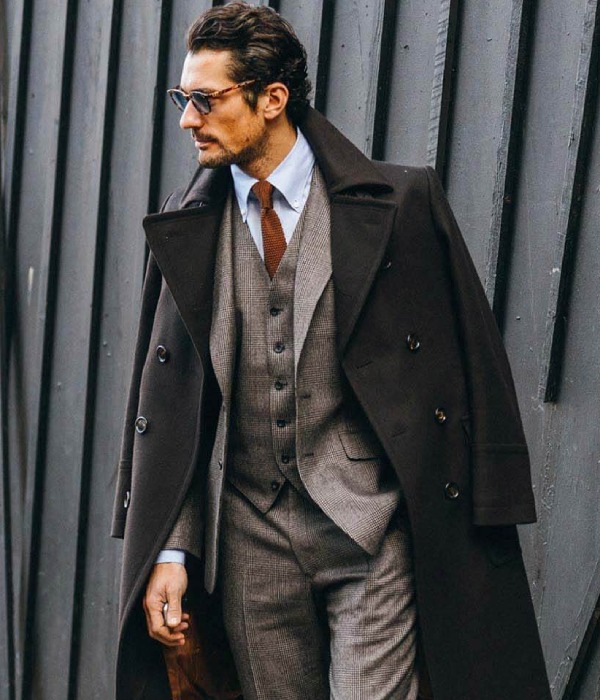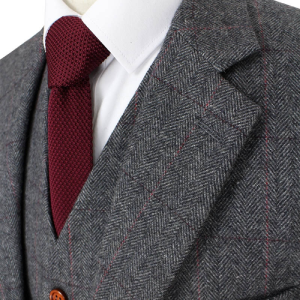
HOW TO PLAN YOUR SUIT THIS JANUARY – A QUICK PLANNER
Even as we’re halfway through the first month of the year, it always pays to put up a blog on how men should plan wearing their suit this January. The fact that you can reuse the suit recommendations year after year makes this an effort worthwhile. The first factor that would help you to plan the right suit is its construction and fabric, depending on how warm you want. You can either go for half-or fully-lined suit jackets, as a matter of preference. Suitable for everyday wear, lined jackets are usually wrinkle-resistant, can retain warmth and outperform well during travel compared to unlined suits. Here’re my recommendations when it comes to choosing the best fabric materials, colors and textures for this month’s suiting.

Wool Suit:
I recommend wool not just because it can keep you warm (of course), but also comes with the ability to drape well, conform to one’s shape, maintain its form, and flexible as a practical material to use—either close-fitting and warm or loose and breathable as required. The most popular material is Worsted wool as it can adapt to changes in temperature, lasts well and gives off appreciable shine found in most premium suits in the marketplace. Other popular types of wool include tweed and flannel. In terms of weight, worsted wool is mid-weight, while tweed is comparatively heavier and flannel is considered as the heaviest.
Tweed is an excellent suit this January because it is warm, thick, durable and water-resistant. Yet still, tweed suits are slightly heavier compared to most other suits, and make a fine winter suit choice because it is thick, warm, water resistant, and durable. However, tweed suits are a little heavier compared with most suits, and the fabric is a coarse of touch.
Flannel, which typically comes from worsted wool, shares a similar look with that of herringbone and tweed, although softer in terms of touch. What I like most about herringbone is that it is chic and stylish, lending the wearer a slightly plaited and shiny appearance. It is also the most luxurious among all the heavier suit fabrics as it is highly soft. All said and done flannel suits are a lot harder to finder and bit exorbitant in case if you want to go for one.
I recommend wool not just because it can keep you warm (of course), but also comes with the ability to drape well, conform to one’s shape, maintain its form, and flexible as a practical material to use—either close-fitting and warm or loose and breathable as required. The most popular material is Worsted wool as it can adapt to changes in temperature, lasts well and gives off appreciable shine found in most premium suits in the marketplace. Other popular types of wool include tweed and flannel. In terms of weight, worsted wool is mid-weight, while tweed is comparatively heavier and flannel is considered as the heaviest.
Tweed is an excellent suit this January because it is warm, thick, durable and water-resistant. Yet still, tweed suits are slightly heavier compared to most other suits, and make a fine winter suit choice because it is thick, warm, water resistant, and durable. However, tweed suits are a little heavier compared with most suits, and the fabric is a coarse of touch.
Flannel, which typically comes from worsted wool, shares a similar look with that of herringbone and tweed, although softer in terms of touch. What I like most about herringbone is that it is chic and stylish, lending the wearer a slightly plaited and shiny appearance. It is also the most luxurious among all the heavier suit fabrics as it is highly soft. All said and done flannel suits are a lot harder to finder and bit exorbitant in case if you want to go for one.
Cashmere Suit:
The Cashmere suit is inarguably the most luxurious suit fabrics of the wool types. Popular for its supremely soft texture, warmth and comfort, the fabric’s demerit is often its high price tag, and it also falls short in terms of durability. Besides being soft and pliant, cashmere can keep you amazingly warm. The fabric, like Worsted wool, can adapt to changes in climatic conditions, and offers excellent insulation while at the same time.
The Cashmere suit is inarguably the most luxurious suit fabrics of the wool types. Popular for its supremely soft texture, warmth and comfort, the fabric’s demerit is often its high price tag, and it also falls short in terms of durability. Besides being soft and pliant, cashmere can keep you amazingly warm. The fabric, like Worsted wool, can adapt to changes in climatic conditions, and offers excellent insulation while at the same time.
Herringbone Suit:
Similar to the tweed in many ways, the Herringbone suit is slightly heavy, warm but durable than the Cashmere Suit. The distinguishing factor between a herringbone and tweed suit is the unique zig-zag pattern. Herringbone suits, like tweed, are manufactured from twilled yarn, generally from materials like flannel or wool. Both herringbone and tweed account for a tighter weave compared to most suits, therefore they are a more durable and structured outfit. The fabric’s thickness, in combination with zig-zag pattern, produces an illusion of depth, and Herringbone suit thus are preferred by the premium consumer segment.
Similar to the tweed in many ways, the Herringbone suit is slightly heavy, warm but durable than the Cashmere Suit. The distinguishing factor between a herringbone and tweed suit is the unique zig-zag pattern. Herringbone suits, like tweed, are manufactured from twilled yarn, generally from materials like flannel or wool. Both herringbone and tweed account for a tighter weave compared to most suits, therefore they are a more durable and structured outfit. The fabric’s thickness, in combination with zig-zag pattern, produces an illusion of depth, and Herringbone suit thus are preferred by the premium consumer segment.
Suit Colors:
Though I always recommend all-season suit staples in navy, black or charcoal, it doesn’t mean that you should blindfoldedly settle for darker hues this January; you can go for a bit of fun with colors. There are some must have fashion staples that you should start implementing for a daring and bolder alternative this winter including Oxblood, Hunter Green, Cognac, Plum, among others. Don’t hesitate to go different with a full suit in any of these hues, or layer it with a colored jacket, pants or suitable accessories.
Though I always recommend all-season suit staples in navy, black or charcoal, it doesn’t mean that you should blindfoldedly settle for darker hues this January; you can go for a bit of fun with colors. There are some must have fashion staples that you should start implementing for a daring and bolder alternative this winter including Oxblood, Hunter Green, Cognac, Plum, among others. Don’t hesitate to go different with a full suit in any of these hues, or layer it with a colored jacket, pants or suitable accessories.
Accessories:
Pick accessories that make for either (dark hues), or those that contrast (bright, patterned) your suit for a positive impact. This month could also be a good time to experiment with more textures and patterns, adding the much needed depth to your overall look.
Pick accessories that make for either (dark hues), or those that contrast (bright, patterned) your suit for a positive impact. This month could also be a good time to experiment with more textures and patterns, adding the much needed depth to your overall look.

